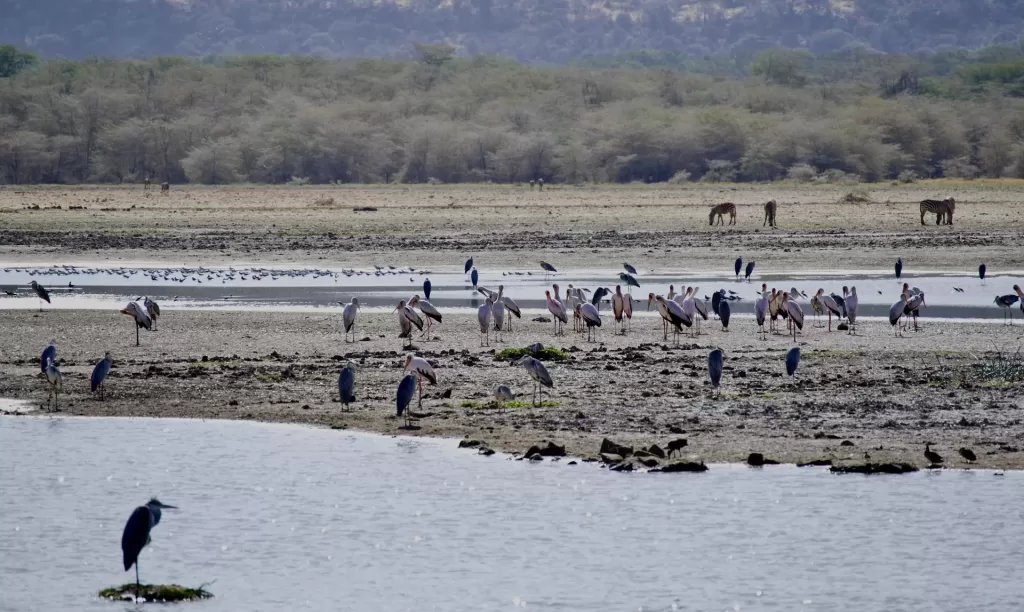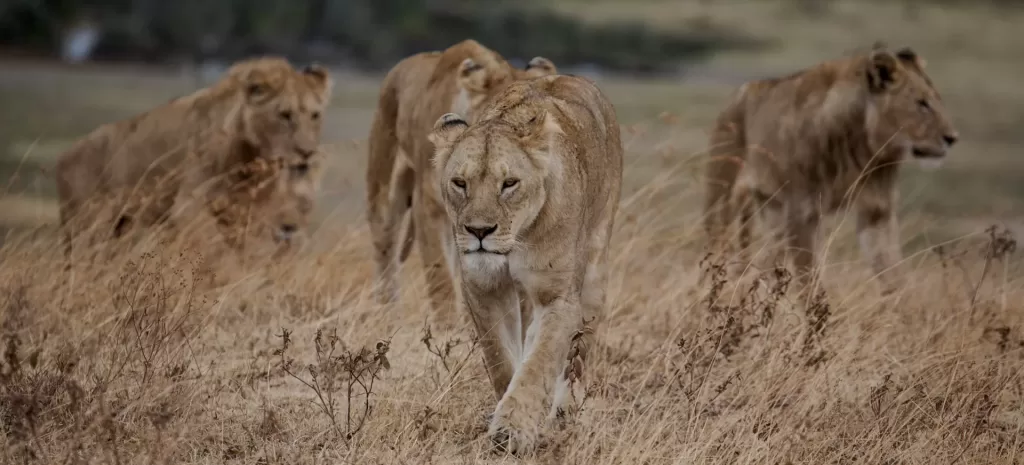Ruaha National Park
Ruaha National Park – Tanzania’s Largest Park
Ruaha National Park sprawls across central to southern Tanzania, situated approximately 130 kilometers west of Iringa, covering a vast expanse of 20,226 square kilometers.
As the largest protected area not only in Tanzania but also in East Africa, it extends its reach to encompass the Usangu Game Reserve, safeguarding vital wetlands and the catchment areas of the Great Ruaha River, preserving its rich biodiversity.
Embedded within the Rungwa-Kizigo-Muhesi ecosystem, Ruaha National Park draws its name from the majestic Great Ruaha River, meandering through its southeastern terrain, serving as a lifeline for a diverse array of wildlife.
The landscape of Ruaha is characterized by its wild and untamed essence, featuring semi-arid vistas adorned with iconic Baobab and acacia trees.
The park teems with a plethora of wildlife species, including buffalo, giraffe, kudu, sable, roan, lion, cheetah, and leopard. Remarkably, it boasts hosting approximately 10% of the global lion population, with around 25 prides often spotted near the Mwagusi River.
Furthermore, Ruaha National Park shelters Tanzania’s largest elephant population and serves as a sanctuary for the critically endangered African wild dogs, underscoring its significance in the conservation landscape.
Things to do in Ruaha National Park
Game Drives
Ruaha national park is home to a 10% population of lions and is easier to see them when you choose to go on a game drive safari in Rhea. The game drive can be done both in the morning as well as in the evening allowing you to get up close and personal with the predator.
Buffalo and elephant herds are found throughout the park but it is the park’s crazy combinations of species from east and southern Africa that excites wildlife enthusiasts.
Discover the wealth of flora and fauna within Ruaha National Park, rendering it a premier safari destination in Africa. Safari trails wind along the perennial Great Ruaha River and the seasonal Mwagusi River, traversing dense forests teeming with a diverse array of wildlife.
Encounter majestic elephants, sleek cheetahs, formidable buffaloes, graceful impalas, stately waterbucks, striped zebras, and elegant gazelles amidst this vibrant ecosystem.
Night drives
A night drive will give you the opportunity to see Ruaha like never before with a chance of seeing nocturnal wildlife and predators when they’re more active. You’ll head out with your guide and a spotlight either at the end of your afternoon game drive or after an early dinner.
The night game drives are available on request, but a ranger has to be obtained from Park HQ and booked in advance.
Wildlife Photography
Ruaha National Park is one of the best spots for wildlife photography of endangered species and their cycle of life. Whether you are a professional of many years or just a beginner, you will have ample opportunity to practice your technique while on safari.
Birding
The park is great for birding with about 570 different species including endemics like the yellow-collared lovebird, the ashy starling, and the Tanzanian red-billed hornbill.
Avid bird watchers have an excellent opportunity to view different species of birds, with a sensational mix of southern and northern species. Bird species include Fish eagles, Eleanora’s falcon, goliath herons, crested barbets, and black-collared lovebirds.
Ruaha also boasts endemic species such as the Tanzanian red-billed hornbill and serves as an important habitat for several critically endangered vulture populations such as the hooded vulture, the white-backed vulture, the white-headed vulture, and Ruppell’s vulture.
Walking Safaris
The walking trails are in the eastern part of the park with chances of viewing massive herds of elephants and buffalo, endless pride of lions, and antelopes.
A bush walk safari is an excellent way to explore the wilderness of Africa with an expert ranger guide, who gives you an insight into the flora, fauna, and lush green scenery of Africa.
Experience the Hot Air Balloon Safari
Early morning, you meet your driver, who will take you to the balloon launch side. This usually takes around 45–90 minutes, and due to the early hour is mostly driven in the dark. Look out for nocturnal animals along the way.
You will arrive just as the balloon is warming up, the burner pumping hot air into the balloon so that it slowly inflates. When everything is ready, you climb into the basket whilst it is still safely tethered, securing yourself in with a safety harness.
Glide over Ruaha National Park taking in spectacular aerial wildlife game viewing with herds of elephants, antelopes, giant kudus, and giraffes quenching thirst by the river, and predators; a hundred birds chirping in the air as well.
Cultural visit
A cultural tour in Ruaha Park gives you an opportunity to get to know more about the tribal people and their way of life. Learn about herding cattle with Maasai warriors, explore the Maasai Boma in the bushlands, and learn skills with local Hehe craftsmen.
Visit the Isimila Stone Age Site which dates back to 1.5 million to 200,000 years ago. The site provides fascinating insights into pre-historic Tanzania, and they are captivating alternatives to exhibits about Tanzania’s colonial history.
Boat safari
A boat safari offers an excellent opportunity to get close to the animals such as hippos, and crocodiles. Exploring the aquatic wildlife on a boat is another level of experience. Look out for animals such as hippos as well as view a lot of game along the river as they come over for a drink of water.
Where to stay in Ruaha National Park
Jongomero Camp
The camp is Located on the banks of the Seasonal Jongomero River in the remote South Western part of Ruaha National Park. Jongomero Camp is the furthest west of any of the camps in the Ruaha National Park.
It lies on the Jongomero Sand River a short distance away from the confluence with the Great Ruaha River and some 70 km from Msembe headquarters.
The camp has its own airstrip which is a short flight (15 minutes) further on from the main Ruaha strip, so although it’s a significant distance from all other camps by road it’s easily accessible by air from Dar es Salaam and Zanzibar.
The Camp comprises 8 large luxurious tents on raised wooden platforms offering double, twin, and single accommodation. Other features include bedside tables and bedside lights; bathroom area with large shower, contained in the tent; solar heated running hot water; spacious private verandah; 24 hours electricity.
Other facilities include the public area including a bar and restaurant, which is beautifully located in the deep shade of an ancient riverine tree with an uninterrupted view of the Jongomero River and bush beyond.
Ruaha River Lodge
Ruaha River Lodge is located within Ruaha National Park on the banks of the Great Ruaha River, about 120km or 2 hours drive from Iringa town and 5 hour’s drive from Mikumi National Park.
The lodge overlooks the Great Ruaha Rover and is built from local stone and thatch blending well into the surroundings. It comprises 24 individual stone and thatched rooms, all with an en-suite bathroom featuring a shower, toilet, and wash basin with solar-heated hot water.
Other facilities include the restaurant serving a variety of dishes using fresh organic produce from the lodge’s Highland farm. A campfire on the river bank, an elevated bar with spectacular views over the river.
Mwagusi Safari Camp
Mwagusi Safari Camp is located along the banks of the Mwagusi River in Ruaha National Park, about 35km from the main park gate, 16km from Msembe airstrip and 120km or 3 hours drive from Iringa town.
The camp is built mostly from natural materials such as grass thatch, timber, driftwood, stones, and reeds perfectly blending with its surroundings.
There are 13 large spacious guest tents or bandas, that are en-suite, with a large covered verandah, a comfortable cushioned seating area, and a swinging hammock, making this the perfect place to relax and view the passing wildlife.
Tandala Tented Camp
Location: Tandala Tented Camp is located just outside Ruaha National Park only 5km from the park main gate, and about 20km from Msembe airstrip, and less than 2 hours drive to Iringa town (100km).
There are 10 spacious, elevated, luxury tents with en-suite bathrooms at the back, enclosed in thatch and rockwork overviewing the bush.
At the front of each room is a verandah with comfortable seating perfect for relaxing in private to watch out for game along the Mdweka sand river. The biggest attraction at Tandala is the abundance of elephants which come and go regularly attracted by the water holes.
The best time to visit Ruaha National Park
The optimal period to explore Ruaha National Park is during the dry season, spanning from June to October. During this time, the vegetation thins out, and wildlife congregates around the remaining water sources, providing abundant opportunities for wildlife viewing.
The month of June is also famous for the Greater Kudu breeding season so if you are lucky you can spot the males.
Ruaha national park is usually hot and dry and the best time to visit this park in Tanzania is during dry season. Since game viewing is one of the best things to do in Ruaha national park so it is best to visit in the dry season as the temperature remains cool and pleasant making it easy to spot the wildlife.
The dry season which is from May to October is an ideal time as the rivers dry up, and more animals congregate around remaining water sources.
The month of June is also famous for the Greater Kudu breeding season so if you are lucky you can spot the males while on your safari tour to Tanzania.
The wet season lasts from November to April and it’s the best season for birdwatching as migrant birds arrive. April and May experience the heaviest rains and many lodges close during this time due to impassable roads.
Getting to Ruaha Park
By Road: The drive from Dar es Salaam to Ruaha is a lengthy one and takes approximately 10 hours with most of it along a dusty bumpy road.
By Air: The nearest airport to Ruaha national park is Julius Nyerere International Airport. The park has two main airstrips Msembe and Jongomero which are located inside the park itself.
Daily flights operate out of Dar Es Salaam, Arusha, and the Selous with Coastal Aviation. The flights take 2.5 hours and then drive to the camps between 2- 3 hours drive.
ABOUT TRAVELERS LINK AFRICA
Our mission at Travelers Link Africa is to connect people to positive travel experiences enabling them to see the world differently, transforming lives and the communities visited.
To do this we offer authentic travel experiences taking you on both an outer adventure and an inner journey to create memories of a lifetime with Uganda, Kenya, Tanzania, and Rwanda
GET SOCIAL WITH US
Follow our Travelers Link Africa adventures and share your own with us
CONNECT WITH US
We’re here to help, so get in touch with our friendly travel consultants to book your package or add customizations your safari
Our main phone number is
+256 754 062 366
– OR –





